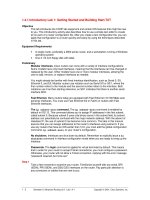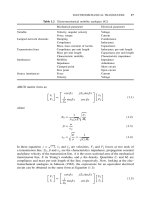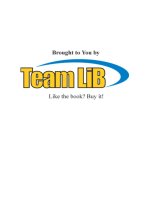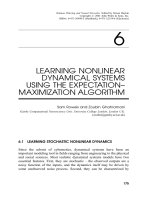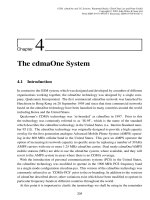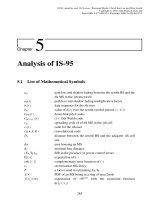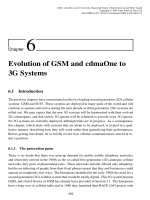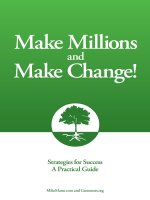Tài liệu Alternative Medicine and Spinal Cord Injury pdf
Bạn đang xem bản rút gọn của tài liệu. Xem và tải ngay bản đầy đủ của tài liệu tại đây (2.15 MB, 226 trang )
Cristian 00 7/6/05 9:40 AM Page ii
Blank Page
Alternative Medicine
and Spinal Cord Injury
Cristian 00 7/6/05 9:40 AM Page ii
Blank Page
Alternative Medicine
and Spinal Cord Injury
Laurance Johnston, Ph.D.
New York
Demos Medical Publishing, LLC, 386 Park Avenue South,
New York, New York 10016
Visit our website at www.demosmedpub.com
© 2006 by Demos Medical Publishing, Inc. All rights reserved. This
book is protected by copyright. No part of it may be reproduced,
stored in a retrieval system, or transmitted in any form or by any
means, electronic, mechanical, photocopying, recording, or other-
wise, without the prior written permission of the publisher.
With permission from the publisher, much of the information in
this book was adapted from an ongoing series of articles published
in PN/Paraplegia News magazine.
Library of Congress Cataloging-in-Publication Data
Johnston, Laurance.
Alternative medicine and spinal cord injury / Laurance Johnston.
p. cm.
Includes bibliographical references and index.
ISBN 1-932603-50-6 (alk. paper)
1. Spinal cord—Wounds and injuries—Alternative treatment.
2. Spinal cord—Wounds and injuries—Patients—Rehabilitation.
3. Alternative medicine. I. Title.
RD594.3.J646 2005
617.4'82044—dc22 2005006521
Printed in Canada.
The purpose of this book is to provide information to readers
so that they can make more informed decisions about their
own healthcare. It should not be construed as medical advice
and readers should always consult with their doctors.
Contents
Foreword ix
Acknowledgments xi
Preface xiii
1. INTRODUCTION 1
2. EASTERN HEALING 13
Acupuncture 13
Acupuncture and SCI 18
Scalp Acupuncture 20
Qigong 25
Ayurveda 31
3. LASER-BASED THERAPIES 39
Laser and Laserpuncture Therapy 39
Laser Acupuncture for Carpal Tunnel 43
Syndrome and Hand Spasticity
4. NATURAL HEALTH AND VIBRATIONAL 51
HEALING
Homeopathy 51
Herbal Medicine 60
Aromatherapy and Essential Oils 67
Flower Essences 75
Edgar Cayce’s Vision: The Golden Touch 81
vii
viii CONTENTS
5. BODYWORK 89
Chiropractic Healing 89
Craniosacral Therapy 96
Chronologically Controlled Developmental 101
Therapy
6. DOLPHIN-ASSISTED THERAPY 105
Is There a Dolphin in the House? 105
7. ELECTROMAGNETIC HEALING 113
Magnetic Healing: Overview 113
Pulsed Electromagnetic Therapy: Diapulse 119
Ferrite-Ring Magnets 124
8. INDIGENOUS HEALING 129
Native-American Healing: Part 1—Philosophy 129
Native-American Healing: Part 2—Healing Modalities 134
9. PRAYER, CONSCIOUSNESS, ENERGY, AND 143
SPIRITUAL HEALING
Part 1: Spirituality and Health 143
Part 2: How Spirituality Can Promote Physical 149
Healing
Mind Instruction: Consciousness-Based Healing 155
10. SCI HEALTH PROBLEMS 165
Natural Urinary Tract Health 165
Natural Prostate Health 171
Nutritional and Botanical Approaches to Diabetes 175
Creating Strength Through Creatine 182
11. THE PARADIGM EXPANDING 191
Inert-Gas Therapy: A New Healing Energy for Spinal 191
Cord Injury?
Index 201
Dedication
This book is dedicated to the Paralyzed Veterans of America (PVA),
whose assistance and association over the years have been greatly
appreciated. Although I have worked for some of the nation’s fore-
most public-health agencies, none have had more heart and soul
than PVA.
Edmund Burke, the 18th-century English philosopher, stated:
“Society is a contract Itisapartnership in all science, a partnership
in all art, a partnership in every virtue and in all perfection. As the ends
of such a partnership cannot be obtained in many generations, it becomes
a partnership not only between those who are living, but between those
who are living, those who are dead, and those who are to be born.”
By building on the contributions of those who have gone before
with a commitment to future generations, PVA has always demon-
strated a commitment to this social contract.
Cristian 00 7/6/05 9:40 AM Page ii
Blank Page
Foreword
A
lternative therapies have traditionally faced great bias from
the biomedical community. However, they should not auto-
matically be discounted because they don’t fit into traditional
medical thinking.
Certainly, researchers need to open-mindedly carry out well-
designed clinical trials to generate scientificproof for newtreatments
for spinal cord injury (SCI), but alternative therapies may help some
people who have SCI.
In an effort to inform subscribers about these nonmedical treat-
ments, PN magazine created the column Healing Options as a
vehicle for disseminating Dr. Johnston’s articles. Carefully re-
searching each topic, Dr. Johnston has, over the years, described a
wide spectrum of alternative modalities. His articles have generated
kudos as well as condemnations. On the one hand, they have con-
cerned some members of the medical community, who adamantly
panned the concepts. On the other hand, many readers responded
with heartfelt thank-yous.
Alternative therapies may not help all people all the time or
even some people all the time, but they may aid some people some
of the time. The most important thing is that the information has
been available. This book has consolidated many of his PN articles,
as wellas other material,into an informative,easily readable resource
for individuals with SCI, health professionals, and others interested
in SCI healing options.
Cliff Crase
Editor, PN Magazine
ix
Cristian 00 7/6/05 9:40 AM Page ii
Blank Page
Acknowledgments
T
here are many individuals I wish to thank for support over
the years and whose contributions at some level contributed
to the book’s evolution.
Foremost, I acknowledge many PVA colleagues, including (1)
Cliff Crase and Ann Santos of PN magazine for creating the Healing
Options series, which laid the foundation for the book; (2) my
former boss and friend John Bollinger; (3) Thomas Stripling and
the Education Foundation Board of Directors for funding my efforts
to expand the healing spectrum; and (4) Mountain-States Chapter
colleagues who published my first foray on this subject in their news-
letter.
I am also deeply thankful for many scientific mentors, including
Dr. Francis Neuhaus, Northwestern University (IL) and Olaf Run-
quist, Hamline University (MN); and the numerous teachers of
alternative and mind–body–spirit healing wisdom who shared para-
digm-expanding insights with me, including Almine Barton, Count-
ess of Shannon.
I am grateful for my many mentors with physical disabilities,
including Dr. David Gray, who shared with me the heart and soul
behind disability, which sometimes is lost in detached policy-making.
I am also appreciative of many policy-making colleagues,
including my former supervisor Dr. Duane Alexander, Director,
National Institute of Child Health and Human Development, who
provided invaluable opportunities to learn about the creation of
disability programs at a national level.
In addition, I am thankful for the friendship of Audur Gudjons-
dottir, Iceland’s 2002 Woman of the Year, who shares with me a
vision of what is possible after SCI if we open-mindedly integrate
divergent pieces of the puzzle that exist throughout the world.
Finally, I am indebted to my parents, Scott and Laura Johnston,
as well as Jean Lindahl, for support at many levels.
xi
Cristian 00 7/6/05 9:40 AM Page ii
Blank Page
Preface
T
his book provides information on alternative and comple-
mentary therapies that can expand the healing spectrum for
individuals with spinal cordinjury (SCI). It discusses healing
perspectives and paradigms that have not been a part of traditional
modern medicinebut that, nevertheless,comprised a keycomponent
of healing armamentaria throughout much of mankind’s history.
The various subjects are frequently discussed from a holistic, mind–
body–spirit view, in contrast to conventional medicine’s reductionis-
tic orientation that views us as a sum of our body parts whether
molecules, cells, organs, or a spinal cord, which can be repaired
in isolation.
In spite of the focus on alternative medicine, this book does
not try to negate modern medicine’s many valuable contributions,
which cumulatively have greatly extended the life expectancy of
individuals with SCI. Most healing traditions have something valu-
able to offer yet, at the same time, have limitations in scope. Modern
medicine emphasizes important pharmacologic and surgical
approaches; however, other healing traditions stress often equally
valid, but different therapies that medicine has traditionally ignored
(for example, until recently, nutrition). It is as if medicine looks at
the world through red-tinted lenses, and other disciplines green,
blue, or yellow lenses. Unless we work together more in unity than
opposition, each discipline’s vision will remain inherently limited.
However, if we open-mindedly accommodate divergent views of
what is possible, we create an expanded healing spectrum that will
benefit all, including those with SCI.
Although it is often assumed that modern medicine represents
safe, proven therapies and that alternative medicine does not, noth-
ing could be further from the truth. In fact, only a small fraction of
xiii
xiv PREFACE
routinely used conventional therapies (including those representing
SCI medicine) are scientifically proven, and, furthermore, through
adverse side effects, medical mistakes, and antibiotic-resistant infec-
tions, conventional medicine has a downside that can inordinately
affect those with SCI. This book provides some wellness-enhancing
alternatives that will reduce exposure to this downside while at the
same time increasing medicine’s power when truly needed.
The book is divided into sections that represent diverse healing
approaches. Following an introduction that reviews why alternative
medicine has become so popular in recent years, chapter 2 discusses
Traditional Chinese Medicine’s acupuncture and qigong and India’s
ancient Ayurvedic healing tradition. Chapter 3 focuses on laser
therapy’s potential to restore some function and treat SCI-associated
hand problems. Chapter 4 reviews various natural and vibrational
healing therapies, including homeopathy, herbal medicine, aroma-
therapy, flower essences, and Edgar Cayce’s SCI approaches. Chap-
ter 5 covers various bodywork approaches, such as chiropractic
and craniosacral therapy. Chapter 6 discusses thought-provoking
dolphin-assisted healing, and chapter 7 reviews electromagnetic
healing. Chapters 8 and 9 move into mind–body–spirit healing
modalities, including indigenous Native-American medicine and the
role of prayer, spirituality, and consciousness. Chapter 10 reviews
naturalistic approaches to enhance urinary tract and prostate health,
fight diabetes, and build strength. The last chapter discusses inert-
gas therapy, a healing modality that incorporates many paradigm-
expanding concepts.
With the support of the Paralyzed Veterans of America, this
book is the product of many years of effort researching various
alternative healing modalities. Considerable time was spent
reviewing each topic, including interviewing many leading experts.
Although much of the material was initially published in some form
in PN/Paraplegia News, a widely circulated magazine in the disability
community, this volume for the first time integrates this extensive
material into a readily assessable and readable resource. While it will
benefit virtually anyone who wishes to learn more about alternative
medicine, it especially targets individuals with SCI, their families,
friends, caregivers, and health-care providers.
Laurance Johnston, Ph.D.
Boulder, CO
1
Introduction
T
he 19th-century Germanphilosopher Arthur Schopenhauer
stated: “Every man takes the limits of his own vision for
the limits of the world.” The purpose of this book is to
provide information on various alternative, complementary, or
energy-based therapies that provide a different “vision for the limits
of the world,” and by so doing, expand the healing spectrum for
spinal cord injury (SCI). For the sake of simplicity, these therapies
hereafter will be collectively called alternative medicine.
Given the book’s emphasis, it is important to note that profes-
sionally I am a product of the mainstream biomedical establishment.
For example, my doctorate is in biochemistry and molecular biology;
and I was an FDA regulatory official, a National Institutes of Health
(NIH) division director, and a director of Paralyzed Veterans of
America’s (PVA) Spinal Cord Research and Education Foundations.
As I began to review and study divergent healing concepts as a result
of PVA funding, my strongly held beliefs on the supremacy of
modern biomedicine started to crumble. As it did, I was able to see
a world of opportunity beyond the banks of the mainstream.
The therapies discussed in this book not only have the potential
to help a variety of SCI-aggravated problems, but they also have
the ability to restore appreciable, quality-of-life enhancing function.
A number of chapters will summarize alternative healing disciplines
and their relevance to SCI, and other chapters will review various
alternative clinics or programs targeting SCI. The book’s overall
purpose is not to advocate alternative over conventional medicine,
but to expand the healing spectrum available to individuals with
SCI, in turn allowing them to make more informed decisions about
their own health care.
1
2 ALTERNATIVE MEDICINE AND SPINAL CORD INJURY
Before we start to discuss various alternative approaches to
healing, we need to address some of the reasons that such approaches
should be considered and dispel some myths about their use, espe-
cially relative to conventional allopathic medicine.
REASONS FOR ALTERNATIVE MEDICINE’S POPULARITY
Although people with SCI have benefited greatly from modern
medicine, like millions of other Americans they are concerned about
the adverse consequences of technology-based medicine and desire
health care with a more holistic perspective. Modern medicine
focuses on fixing the symptoms, often ignoring the underlying
mind–body–spirit causes. Under the pretext of scientific objectivity
and reductionism, medicine detaches itself from the patient’s
uniqueness and operates by isolating and fixing the dysfunctional
item in the absence of the big picture.
In contrast, many alternative healing traditions have more of
a holistic view that focuses on disease causes and not merely on
symptoms. Because most illnesses have mind–body–spirit contribu-
tions, effective health care should consider all three. In spite of
many breakthroughs, conventional medicine often has limited per-
spectives, especially when it comes to chronic health issues. For
example, although nutrition is probably the most important factor
to long-term health, most medical schools do not require a course
in nutrition.
Dr. Wayne Jonas, former director of the NIH Center for
Complementary and Alternative Medicine, summarized some of the
reasons for the surge in popularity of alternative medicine (1),
including
a rise in prevalence of chronic disease, an increase in public access
to worldwide health information, reduced tolerance for paternalism,
an increased sense of entitlement to a quality of life, declining faith
that scientific breakthroughs will have relevance for the personal
treatment of disease, and an increased interest in spiritualism. (p.
1616)
He also notes that there is growing concern about the adverse effects
and escalating costs of conventional care.
DEFINITION
Depending on one’s viewpoint, alternative medicine definitions can
vary greatly. For example, in the United States acupuncture is an
INTRODUCTION 3
alternative therapy, but in China it is traditional medicine. Face-
tiously, consumers define alternative medicine as therapies they paid
for out of their own pockets but did not feel comfortable discussing
with their physicians. In contrast, physicians define it as quackery
because it was not a part of their medical school curriculum.
Dr. Daniel Eskinazi proposed that alternative medicine be
defined “as a broad set of health-care practices (i.e., already available
to the public) that are not readily integrated into the dominant
health-care model because they pose challenges to diverse societal
beliefs and practices (cultural, economic, scientific, medical, and
educational)” (2).
TRENDS
Because of consumer demand for health care options, there has
been incredible growth in alternative medicine. Dr. David Eisenberg
et al. reported that 40% of Americans used alternative therapies in
1997 (3). Between 1990 and 1997, visits to alternative practitioners
jumped 47%. Over that same period, Americans visited alternative
providers 629 million times compared to 386 million visits to pri-
mary care physicians. Ninety percent of alternative medicine users
are self-referred (4); that is, they are educating themselves and not
relying on traditional medical authorities.
Although the medical establishment frequently criticizes alter-
native healing,many rank-and-file physicians desire additional train-
ing in alternative therapies. For example, one survey indicated that
49% of primary care physicians want homeopathy training (5).
Although curriculum content is uncertain, the majority of medical
schools now offer some training in alternative medicine (6); and as
health care consumers, 39% of family physicians use herbal reme-
dies (7).
INDIVIDUALS WITH DISABILITIES
This grassroots movement seems especially true for people with
disabilities, even in spite of their traditional reliance on conventional
health care. According to analyses of the 1999 National Health
Interview Study (personal communication, Dr. Gerry Hendershot,
November 2, 2001; 8), they are using alternative medicine even
more than able-bodied individuals are. For example, adults with a
4 ALTERNATIVE MEDICINE AND SPINAL CORD INJURY
disability are 1
1
/
2
to 2
1
/
2
times more likely to use prayer or spiritual
healing for health care than are adults without a disability.
FIRST, DO NO HARM
It is often assumed that conventional medicine has been proven safe
and alternative medicine has not been. This assumption is false.
Although modern medicine’s many contributions have greatly bene-
fited people with SCI, it also has a downside that inordinately affects
them. Examples include the following:
• Annually, 106,000 people die from adverse drug reactions in
hospitals, making it the nation’s fourth to sixth leading cause of
death (9). Painkillers alone, which people with SCI often rely
on, hospitalize more than 76,000 people each year because of
gastrointestinal complications (10). (In comparison, herbal rem-
edies kill 50 to 100 people a year.)
• Almost 2 million people who enter hospitals in this country get
infections they did not have when they went there. Of these,
80,000 die (11).
• According to the National Academy of Sciences, medical mis-
takes kill 44,000 to 98,000 people annually (12).
• Finally, studies suggest that hospital care in general rates as the
third major killer in the country, following heart disease and
cancer (13).
These statistics are especially relevant to people with SCI, who
often are prone to overmedication, life-threatening infections, and
more hospitalization. Clearly, such statistics warrant a serious con-
sideration of alternative therapies, such as those summarized in
this book.
DOUBLE-BLIND OR DOUBLE STANDARD
Although it is true that many alternative therapies have not been
well tested, the prevailing assumption that conventional medicine
represents scientifically well-tested procedures is inaccurate. For
INTRODUCTION 5
example, the Congressional Office of Technology Assessment (as
well as others) concluded that only 10% to 20% of conventional
medicine techniques have been scientifically proven (14). The dou-
ble standard was underscored by a prestigious National Institutes of
Health (NIH) Consensus Conference when discussing acupuncture
(15). The conference concluded, “While it is often thought that
there is substantial research evidence to support conventional medi-
cal practices, this is frequently not the case thedata in support
of acupuncture are as strong as those for many accepted Western
medical therapies” (p. 13).
ENERGY MEDICINE
One key feature that is often inherent in ancient or Eastern healing
traditions and characterizes numerous alternative healing traditions
is the concept of energy. Many scientists are beginning to explain
energy concepts through an emerging mind–body discipline called
psychoneuroimmunology. This is a long word for a simple idea:
basically, your emotions, attitudes, and consciousness affect your
physical health by releasing beneficial neurological agents, hor-
mones, and immune-enhancing substances. An example of this is
meditation, which produces profoundly beneficial physical effects.
For example, those who meditate visit doctors half as much as those
who do not; have lower rates of cancer, heart disease, and substance
abuse; and age more slowly.
Although disciplines like psychoneuroimmunology are begin-
ning to bridge the gap, historically there has been a huge philosophi-
cal difference between conventional medicine and energy-based
healing traditions. Medicine’s mechanistic perspective assumes the
body’s biochemistry is paramount, whereas the energy model
believes that the biochemistry is subordinate to the body’s energy.
As discussed by Dr. Roberta Trieschmann (16, 17), conventional
medicine assumesthat physical health produces happiness and there-
fore considers emotional reactions, meaning of life, and belief sys-
tems to be irrelevant to medicine. In the energy model, happiness
leads to physical health, and thus our beliefs, the meaning we attach
to daily events, and our emotional reaction to these events are crucial
to health and well-being.
6 ALTERNATIVE MEDICINE AND SPINAL CORD INJURY
MEDICINE AS A PREVAILING PHILOSOPHY
Many alternative healing traditions emphasize the role of spirituality
or consciousness. In contrast, modern medicine is based on a mecha-
nistic view of the body. Within this view, the body represents a
summation of individual parts (molecules, cells, organs, etc.), and
as a result must be healed by fixing the parts. Under such a model,
spirituality or consciousness has no relevance to health.
Dr. Daniel Eskinazi states that under conventional medicine’s
materialism philosophy “physical matter is the only fundamental
reality, and that all beings and processes and phenomena are mani-
festations or results of matter” (p. 1621). He argues:
As it has not been demonstrated that physical matter is the only reality,
materialism, therefore is akin to a religion, i.e., a system of beliefs held
to with ardor and faith. Western allopathic medicine, therefore re-
flects the dominant philosophical belief system of the society in which
it developed. (2, p. 1622)
FACTORS THAT KEEP ALTERNATIVE
THERAPIES ON THE FRINGE
Economic
Our health care has been determined as much by economics, politics,
and professional chauvinism as by objective science. These factors
have created the most expensive health-care system in the world,
which, in spite of its cost, is not that good compared to other
countries. For example, in a 13-country comparison study, the
United States ranked an average of 12th for 16 health indicators
(13). Given that many individuals with SCI are at the lower rung
of the nation’s socioeconomic ladder, our costly, suboptimal health
care disproportionately affects them, once again suggesting the con-
sideration of cheaper, less risky, and perhaps more effective alterna-
tives.
One key economic issue is the regulatory approval process. In
view of the daunting economics needed to prove the safety and
efficacy of any new treatment, few alternative therapies, regardless
of merit, will survive the regulatory testing gauntlet. Basically, we
have adopted a regulatory process that only works well for patentable
therapeutics with large markets and deep-pocket financial sponsors
INTRODUCTION 7
(e.g., drug companies). Given that it often costs hundreds of millions
of dollars to carry out the testing needed to bring a new medicine
to market, the market size for many disabilities, including SCI, does
not justify the expenditure and effort from a profit-generating view.
Because many generic alternatives cannot be patented, economic
incentives are lacking.
There are many examples of economic factors influencing the
nation’s health care that work against alternative therapies. For
instance
• Physicians obtain most of their information on medicines from
the profit-motivated pharmaceutical industry.
• The majority of medical consultants who advise public-health
agencies have financial conflicts of interestwith the drugindustry
that their decisions profoundly influence (18).
• There is a strong association between authors’ published posi-
tions on drug safety and their financial relationship with drug
companies (19).
• Drug advertising has increased a thousandfold in recent years
(20).
• Drug companies spend an average of $13,000 a year on each
U.S. physician to market their products (21).
Resistance by Organized Medicine
Many alternative treatments have a history of suppression by the
allopathic medical establishment. For example, after acupuncture
started to become popular in the 1970s, the American Medical
Association (AMA) pressured the Food and Drug Administration
(FDA) to ban acupuncture needles except for use in a research
protocol. Control issues remain to this day. As another example,
the NIH Consensus Conference mentioned earlier concluded that
acupuncture should be used only after a patient has seen an MD,
ignoring a training differential in which physicians can practice
acupuncture therapy after 200 hours of training, whereas non-MDs
must train 3 years in an accredited school of Oriental medicine.
In yet another example, the AMA—which was founded largely
to fight homeopathy—did everything in its power to squelch the
8 ALTERNATIVE MEDICINE AND SPINAL CORD INJURY
discipline. In spite of growing evidence, including double-blind
clinical trials that support homeopathy’s use, dogmatic opposition
continues to this day as documented by a state medical board’s
revoking the license of a homeopathy-practicing physician.
In a final example among many, chiropractic historically has
faced vociferous opposition from organized medicine. This opposi-
tion lasted until a 1987 federal antitrust ruling found the AMA
guilty of a prolonged systematic attempt to undermine completely
the chiropractic profession, often using highly dishonest methods.
Limited Scientific Perspectives
Traditionally, scientists downplay the importance of phenomena
they cannot explain. However, if we learn anything from the lessons
of history—such as the persecution of Galileo for proving that the
Earth moves around the sun or the ridiculing of Ignaz Semmelweis
for audaciously suggesting that physicians wash their hands—it is
that today’s state-of-the-art beliefs are tomorrow’s anachronisms.
One of my most powerful personal examples of this phenome-
non involves Sir Hans Krebs, who was awarded the 1953 Nobel
Prize for elucidating core biochemical pathways and whom I met
when I was a fledgling biochemist. He showed me a slide of a form
letter he had received from the prestigious journal Nature, rejecting
his seminal work for publication because of insufficient scientific
merit. Today, as I write about therapies that frequently challenge
the status quo, I often reflect on Krebs’ rejection letter. If the father
of modern biochemistry could be rejected by prestigious scientific
authorities, I wonder what innovative, function-restoring therapies
we are rejecting today. What amazes me is that condemnation is
not limited to those who advocate the status quo. I have noted
consistently that innovators who desperately want acceptance for
their therapy are often the first to condemn someone else’s innova-
tion.
Many alternative therapies involve paradigm-expanding per-
spectives not well appreciated by bioscientists who feel that physio-
logical phenomena must be explained through biochemical
mechanisms they understand. For example, bioscientists dismiss
homeopathy because it cannot be comprehended pursuant to tradi-
tional biochemical principles. Understanding homeopathy required
INTRODUCTION 9
physicists, who understood quantum physics, chaos and complexity
theory, and so forth. Similarly, acupuncture’s life-force qi energy
was beyond the pale of Western scientific thought, yet it is now
being explained through subtle electromagnetic-energy effects.
In addition, for many alternative therapies, the specific treat-
ment is based on the patient’s unique symptoms and not on the
disorder by name. Nevertheless, in numerous studies scientists have
ignored this underlying precept and have given the same interven-
tion to all subjects in the treatment group instead of individualizing
the treatment according to symptoms. When the results wereambig-
uous, they questioned the therapy instead of their methodology.
Research Funding
Although alternative therapies are often criticized for being scientifi-
cally untested, relatively little money has been provided for such
testing. For example, the NIH National Center of Complementary
and Alternative Medicine program for evaluating alternative modal-
ities represents less than half of one percent of the NIH budget.
Given alternative medicine’s immense popularity, this is a huge
budgetary discrepancy and makes one wonder how relevant NIH
truly is to real-world health care. When Congress forced NIH to
establish the center more than a decade ago, it was initially named
the Division of Unconventional Medical Practices, which, consider-
ing the bureaucratic importance of acronyms (“DUMP”), suggested
its relative NIH priority.
ARE WE GOOD WORLD CITIZENS?
Most of the world’s population cannot afford high-technology
Western medicine and often must rely on traditional or indigenous
healing therapies. For example, Somalia’s per capita health-care cost
is $11 compared to $5,000 plus in the United States. If we are going
to be good world citizens, concerned about other humans, we need
to consider these economic health-care disparities when we develop
policies for treating SCI. In view of such considerations, the World
Health Organization has recommended that alternative, comple-
mentary, and indigenous medicine be integrated into national
health-care policies and programs (22).
